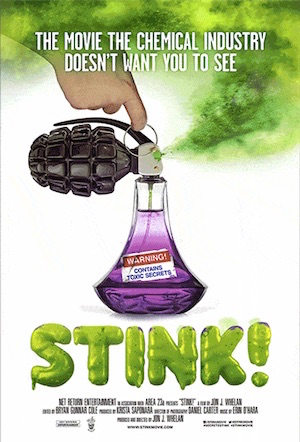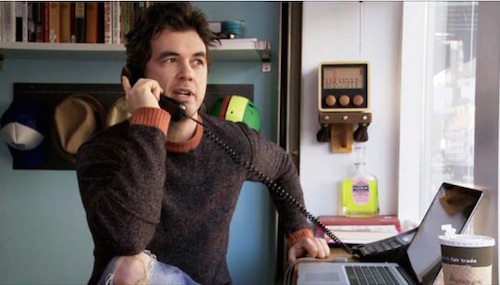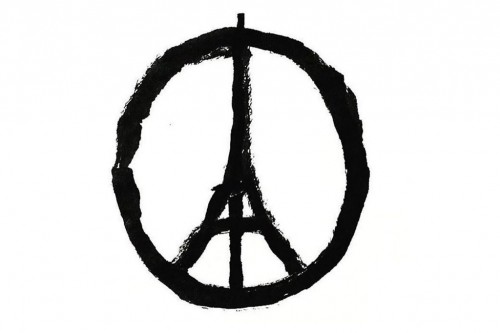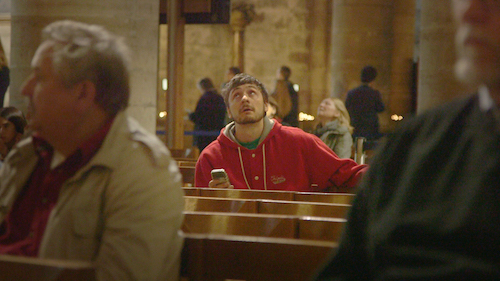- 8 years ago
-
“This is a love story, a mystery, a crime drama, a wake-up call and a farce,” begins Jon J. Whelan’s voiceover in his new documentary Stink! Though a fairly modest enterprise, the film does manage to incorporate all those elements into a cohesive package. Stink! is essentially an eye-opening exposé of the unregulated or under-regulated use of chemicals in cosmetics, household products and clothing in the U.S. Whelan, whose own personal tragedy led him to pursue the subject, figures prominently in the film; he’s reminiscent of a low-key Morgan Spurlock or a more affable Michael Moore.
Stink!– and Whelan’s quest – starts when the widowed filmmaker orders pajamas for his young daughters from the popular tween-tailer Justice. His attempts to find out what makes the PJ’s smell bad are met with uncooperative ignorance on the part of the company, from customer service reps to its CEO; basically, chemicals used in the clothing cannot be divulged as it is “proprietary information.” That phrase soon becomes a loathsome mantra on the part of manufacturers and those representing the chemicals industry as a legal excuse to protect themselves. Whelan decides to send the offensive PJ’s to a lab for analysis…
 Meanwhile, the movie gives us some pertinent history: A 2009 government report warned that environmental toxins are seriously underestimated. Flashback to President Nixon’s National Cancer Act of 1971 and the ensuing 1976 Toxic Substances Control Act, which was supposed to regulate new chemicals, but has been virtually toothless in the face of opposition from trade associations and the powerful American Chemistry Council. The main loophole in existing regulations is that chemicals used in a product’s fragrance do not have to be identified on its label. And the fragrance industry, a behemoth business, has successfully fought regulation every step of the way. As Whelan notes, the FDA may regulate what goes into our mouths, but not what goes onto our bodies.
Meanwhile, the movie gives us some pertinent history: A 2009 government report warned that environmental toxins are seriously underestimated. Flashback to President Nixon’s National Cancer Act of 1971 and the ensuing 1976 Toxic Substances Control Act, which was supposed to regulate new chemicals, but has been virtually toothless in the face of opposition from trade associations and the powerful American Chemistry Council. The main loophole in existing regulations is that chemicals used in a product’s fragrance do not have to be identified on its label. And the fragrance industry, a behemoth business, has successfully fought regulation every step of the way. As Whelan notes, the FDA may regulate what goes into our mouths, but not what goes onto our bodies.There’s cause for concern: aside from rises in certain types of birth defects, autism and other conditions, the rate of breast cancer has increased from one in 20 women in the 1960s to one in eight, which is especially worrying to Whelan; his wife Heather died of the disease in 2009 and he is raising two daughters. Heather’s story is slowly and straightforwardly divulged via photos and home movie snippets, interspersed throughout the film along with interviews with activists and legislators fighting for transparency, and Whelan’s own attempts to engage various industry figures regarding the loophole.
He includes the story of teenage Brandon Silk, whose near-fatal allergic reaction to AXE body spray led his mother on a futile mission to identify the chemical that is so harmful to her son. (Of course the formula is “proprietary.”) Most maddening perhaps is the fact that Europe and China, among other nations, abide by the “precautionary principle” when it comes to chemicals and thus have much stricter regulations than we do. Their cheaper, sub-standard products are dumped in the U.S. market where questionable chemicals are innocent until proven guilty. (Except they often can’t be proven guilty since manufacturers don’t have to divulge all the ingredients in their formulas.) Unsurprisingly, the lab report on Whelan’s daughters’ pajamas is not good.
Throughout the movie, Whelan, a likable everyman sort, catches up with various stakeholders including Justice CEO Michael Rayden, lobbyist Steve Rosario, New Jersey Rep. Leonard Lance, whose 2012 Cosmetic Safety Amendments Act is widely endorsed by the cosmetics/personal care industry, and Calvin M. Dooley, president and CEO of the American Chemistry Council, none of whom seem willing to answer his pointed questions about chemicals used in children’s clothing or the fragrance loophole. Though Whelan admits that he’ll never know the cause of his wife’s cancer, there is no denying the fact that there has been an increase in our collective “body burden” of chemicals over the years, and that the prevailing business model favors profits over caution, or even common sense.
Stink! ends with Whelan’s oldest daughter on the phone with Aeropostale, trying to find out if flame retardant chemicals are used on the company’s clothing and eliciting the same non-answers her father has gotten throughout the film. An enlightening look at an issue that most of us are already somewhat familiar with, the film serves as a reminder to be wary of the everyday products we use. Clearly we’re the only ones really watching out for ourselves.
Stink! opens this Friday at Cinema Village in Manhattan.
—Marina Zogbi
Latest News
- 8 years ago
-
The deplorable terrorist attacks in Paris on Friday November 13 has left 352 wounded and has tragically claimed 129 lives, including an aspiring designer named Nohemi Gonzalez, studying abroad from California.
Fashion blogger, Mai Hua New York Times thought that the explosions “were just another burst of gang violence,” while a woman picking up Chinese takeout recalls a terrifying account of people “hiding under tables,” and her car “riddled with bullets.”
It’s painful and difficult to fully imagine the entire weight of horror these innocent people experienced, and our hearts go out to all of the victims and lives lost. And this weekend, the heartfelt sympathy in the wake of this heinous can be seen all over social media, especially within the fashion community.
Photo Credit: Jean Julien
See below some of the outpouring of love and support from such leading members of the fashion world, including Valentino, Ralph Lauren and Christian Louboutin .
Jacqueline Colette Prosper, yummicoco.com
- 8 years ago
-
Hot Sugar’s Cold World, Adam Bhala Lough’s engaging new documentary, begins with the title musician/producer recording the sound of Pop Rocks candy dissolving in a young woman’s mouth. It’s as good an introduction to the iconoclastic Hot Sugar (Nick Koenig) as any: this New York-based musical alchemist creates highly atmospheric compositions out of myriad everyday sounds. His moody, multi-layered electronic music has become the main soundtrack for Comedy Central’s Broad City and has graced tracks by rappers Antwon and Heems, in addition to many other Koenig collaborators. (One of his first high-profile production credits was for the song “Sleep” from The Roots’ 2011 concept album undun.) The movie invites us to watch — and ultimately marvel at — Koenig’s unorthodox, intensely personal process.
Something of a wunderkind, Koenig found his MO years ago as a young hip hop fan, when he realized that “everyone winds up using the same sounds,” so he decided to make his own. Hot Sugar’s Cold World follows Koenig over several months as he creates his music in a variety of environments and cities; collaborates and hangs out with assorted luminaries including Jim Jarmusch, actor Martin Starr and Heems (Himanshu Kumar Suri); queries astrophysicist Neil deGrasse Tyson about the nature of sound; and talks about his process and his life. At one point in the film, he breaks up with his girlfriend, Internet-famous rapper Kitty, seemingly due to conflicting touring schedules and the damaging effect of online commenters.
It’s clear that Koenig is driven to find and record sounds. Early in the film, he fakes interest in purchasing a $90,000 Steinway baby grand piano, mainly to record himself playing it for a future composition. At another point, he has an intern call a funeral home in hopes of recording the silence in a viewing room. (He’s turned down, but will get the opportunity later in a more personal setting).
“Recording sounds is the closest I have to having control over anything in life,” he explains. As for traditional recording, “There are no rules; the people who wrote the rules are playing it safe.”
Koenig travels to Paris and stays in the apartment of his grandparents, Holocaust survivors whose ordeal “makes me feel like the most worthless piece of shit,” for complaining about his own problems. A brooding sort possessed of a romantically morbid streak, he visits and records sounds at their grave, as well as in the Catacombs, where his messing with skulls and bones sets off an alarm. He later plays a cathartic club show where swaying attendees are transported by his music.
Though his pronouncements (“There’s no point to drums anymore…People rely on humanity too heavily”) seem somewhat anti-human, his music is undeniably compelling. We see Koenig’s method, from recording a specific sound, to digitally manipulating it into a usable recording, to incorporating it into baroque, often haunting, compositions. There’s seemingly nothing — a dollhouse on fire, a fountain pen — that isn’t sonic fodder for him, and often these sounds hold a deeper meaning. This is “associative music,” which contains sounds that evoke certain responses in the listener, even if they don’t realize what they’re hearing.
On a visit to UCLA, Koenig visits the room where the Internet was invented, part of a project to record the silence of meaningful locations. Back in New York at the Rose Center for Earth and Space, he seems happy with Degrasse Tyson’s ideas about sound and silence. (Naturally, he later uses the renowned scientist’s recorded voice in a composition.)
Hot Sugar’s Cold World is a absorbing portrait of a musician whose approach may at first come across as gimmicky and self-indulgent, but who appears to be on a genuine search for meaning. By film’s end, there is no doubt that he is a true artist with a worthwhile mission: “I want to capture the beauty of the world… I record these things to remind me, so every time you listen to music you hear the beauty.”
Viewers should pay attention to the final credits, which includes a long and varied list of sounds used in the making of the movie, i.e., “lipglossed lips kissing air,” “petting cactus,” “petting velvet” and “snails eating money.” Definitely one of a kind.
Hot Sugar’s Cold World is available on digital platforms including iTunes, XBox, Vimeo, Amazon and Google Play.
—Marina Zogbi
- 8 years ago
-
Halloween is barely behind us and yet the storefronts and Starbucks cups are already all geared up for Christmas. The holidays are still a solid month away. We still have Thanksgiving and the start of winter to get through. Let’s focus on the present and all the good albums that have come out instead of decking the halls in November. Based on the past month and the beginning of this one, it looks like 2015 is going to close strong. Releases have included Matt Berninger’s new project El Vy as well as relative newcomer Alex G. Here are some of our favorite releases of late:
“Need A Friend” by El Vy Off of the band’s debut Return to the Moon, “Need A Friend” is a great example of how The National’s Matt Berninger and Ramona Falls/Menomena’s Brent Knopf have combined two fairly different sounds together to craft a new, just as good one. Berninger is known for velvety, smoldering vocals set to sweeping instrumentals whereas Knopf is typically springier, stranger and heavier on the synth. El Vy doesn’t sound like either of those things, but it’s already a favorite. Other tracks of the record, like “I’m the Man to Be”, are downright goofy compared than their usual tones, which makes “Need A Friend” a good mid-ground to start from when getting to know the group.
For Fans of: The National, Menomena, Minutemen“Josephine” by Frank Turner
For Fans of: Frightened Rabbit, Admiral FallowEnglish folk/singer-songwriter Frank Turner has been churning out heart-wrenching, honest songs for just about a decade now. His most recent record Positive Songs for Negative People is a continuation of autobiographical lyrics and pounding melodies. The record also continues on the vein of redemption and positivity that Turner began several releases ago. “Josephine” is just this. On an unrelated note, the album is Turner’s most popular to date. Turner has been using his new found popularity for good. He launched #FTRAOK, a hashtag meant not only to celebrate the release, but also to “showcase some of [his] and [his fan’s] best examples of Random Acts Of Kindness.”
“Wasted Love” by City and Colour As a solo artists, Dallas Green sounds nothing like his previous project, post-hardcore band Alexisonfires. For this new iteration, he’s gone from screaming vocals to a calmed hum. Fans of his heavier work may not immediately gravitate to his new sound; however, they shouldn’t dismiss his folk effort just yet. Lyrically, there is a lot of similarities as well as literal carryover between the two bands. The lines “And do you think I would call just to hear you breathe?” and “And I know there is some place I can go where no one knows my name?” feature in both Alexisonfire and City and Colour songs. It’s clear that the same man is behind both sets of words and that he executes each with the same precision of skill.
For Fans of: Iron & Wine, Ray LaMontagne, Bon Iver“Bug” by Alex G Alex G (Alex Giannascoli) sounds like something out of the 90s (think: early Pavement) mixed with modern indie rock. The Pennsylvanian multi-instrumentalist has an impressive number of releases under his belt (most of which are self-released) given his age. Out of the dozen or so records, his first label-backed release, DSU, came out only last year and earned him a lot of much deserved attention. The culmination of this catalog and the twenty-something’s efforts is his most recent album Beach Music, which is his first record with the label Domino. The album has already been labeled an essential by Spin and has gained similar praise from Pitchfolk and Consequence of Sound. It’s opening track “Bug” is true to his sound and a good introduction to his casually intricate sound.
For Fans of: Elvis Depressedly, Car Seat Headrest, Girlpool“Weave” by Foxing Two years ago around, Foxing released their debut album The Albatross. They subsequently signed to Triple Crown Records, who re-released the album, and toured in support of it through the year with bands like Modern Baseball, mewithoutYou and Brand New. The band announced their second Triple Crown release Dealer, an atmospheric indie follow-up, this summer. They premiered the single “The Magdalene” over on NPR’s all songs considered in August. The track deals with frontman Conor Murphy’s upbringing in Catholic school. The rest of the record has a similarly personal, soft feel to it. “Weave” characterizes this more refined sound that the band has move towards since their last record.
For Fans of: TWIABP, Into It. Over It.-Zoe Marquedant
- 8 years ago
-
I once read that people who see faces in inanimate, non-portrait objects, are neurotic, and the article did not mean that endearingly. If that’s true, then children who make animal and human shapes out of clouds (so many) are neurotic. And truthfully, most artists are too. So with that, I will use this post to talk about an artists who plays with this idea in a rather beautiful way, and to tip my hat to those individuals who choose to and are able to view the world in a more fascinating way.
Jane Lafarge Hamill‘s paintings combine traditional portraiture with modern abstraction. Her works first appear as a slather of saturated, vibrant colors, enhanced by her thick application of paint. However, though appearing haphazard, the way she has manipulated the paint allows for a vague, albeit familiar, image of a human’s face to come through. Depending on how she has arranged the lines sometimes the face is in profile, sometimes face front.
What really allows for the portraits to be visualized is not in the revelation of facial features, as they are pretty blurry, but in the way the lines make up the shape of the head – the forehead, jawline, and neck specifically. While this alone makes her painting style unique, what makes her work beautiful is her use of color. Her pieces are not exceptionally large, rather they are on the smaller side, yet they instantly pop out due to the layers of applied color and the vibrancy of the palette.
What is especially contemporary about her paintings is the ambiguity of gender in the portraits. I would be interested to hear who sees what gender, if at all, in the works. It allows for individual readings. Some of the best art I’ve seen recently leaves interpretation open to the viewer rather than forcing them to see something preconceived. This ultimately fosters a deeper personal connection for the viewer to her paintings, and therefore doesn’t distance art from the mass public.
All in all Jane Lafarge Hamill’s works are complicated in technique but approachable in her romantic brushstrokes, color. Her dedication to the craft of painting has allowed her works to retain a modernist, contemporary spirit of narrowing the gap between viewer and artwork.








